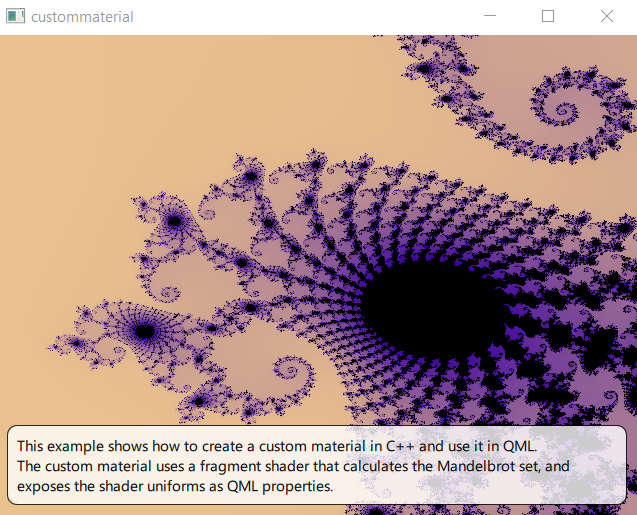Warning
This section contains snippets that were automatically translated from C++ to Python and may contain errors.
Scene Graph - Custom Material#
Shows how to implement a custom material in the Qt Quick Scene Graph.
The custom material example shows how to implement an item that is rendered using a material with a custom vertex and fragment shader.
Shader and material#
The main functionality is in the fragment shader
<Code snippet "/data/qt5-full-671/6.7.1/Src/qtbase/scenegraph/custommaterial/shaders/mandelbrot.frag" not found>
The fragment and vertex shaders are combined into a QSGMaterialShader subclass.
class CustomShader(QSGMaterialShader): # public CustomShader() setShaderFileName(VertexStage, ":/scenegraph/custommaterial/shaders/mandelbrot.vert.qsb") setShaderFileName(FragmentStage, ":/scenegraph/custommaterial/shaders/mandelbrot.frag.qsb") bool updateUniformData(RenderState state, QSGMaterial newMaterial, QSGMaterial oldMaterial) override
A QSGMaterial subclass encapsulates the shader together with the render state. In this example, we add state information corresponding to the shader uniforms. The material is responsible for creating the shader by reimplementing createShader() .
class CustomMaterial(QSGMaterial): # public CustomMaterial() QSGMaterialType type() override int compare(QSGMaterial other) override QSGMaterialShader createShader(QSGRendererInterface.RenderMode) override return CustomShader() class(): center[2] = float() zoom = float() limit = int() dirty = bool() } uniforms
To update the uniform data, we reimplement updateUniformData() .
def updateUniformData(self, RenderState state, QSGMaterial newMaterial, QSGMaterial oldMaterial): changed = False buf = state.uniformData() Q_ASSERT(buf.size() >= 84) if state.isMatrixDirty(): m = state.combinedMatrix() memcpy(buf.data(), m.constData(), 64) changed = True if state.isOpacityDirty(): opacity = state.opacity() memcpy(buf.data() + 64, opacity, 4) changed = True customMaterial = CustomMaterial(newMaterial) if oldMaterial != newMaterial or customMaterial.uniforms.dirty: memcpy(buf.data() + 68, customMaterial.uniforms.zoom, 4) memcpy(buf.data() + 72, customMaterial.uniforms.center, 8) memcpy(buf.data() + 80, customMaterial.uniforms.limit, 4) customMaterial.uniforms.dirty = False changed = True return changed
Item and node#
We create a custom item to show off our new material:
from PySide6.QtQuick import QQuickItem class CustomItem(QQuickItem): Q_OBJECT Q_PROPERTY(qreal zoom READ zoom WRITE setZoom NOTIFY zoomChanged) Q_PROPERTY(int iterationLimit READ iterationLimit WRITE setIterationLimit NOTIFY iterationLimitChanged) Q_PROPERTY(QPointF center READ center WRITE setCenter NOTIFY centerChanged) QML_ELEMENT # public CustomItem = explicit(QQuickItem parent = None) def zoom(): return m_zoom def iterationLimit(): return m_limit def center(): return m_center # public slots def setZoom(zoom): def setIterationLimit(iterationLimit): def setCenter(center): # signals def zoomChanged(zoom): def iterationLimitChanged(iterationLimit): def centerChanged(center): # protected QSGNode updatePaintNode(QSGNode , UpdatePaintNodeData ) override def geometryChange(newGeometry, oldGeometry): # private m_geometryChanged = True m_zoom = qreal() m_zoomChanged = True m_limit = int() m_limitChanged = True m_center = QPointF() m_centerChanged = True
The CustomItem declaration adds three properties corresponding to the uniforms that we want to expose to QML.
Q_PROPERTY(qreal zoom READ zoom WRITE setZoom NOTIFY zoomChanged) Q_PROPERTY(int iterationLimit READ iterationLimit WRITE setIterationLimit NOTIFY iterationLimitChanged) Q_PROPERTY(QPointF center READ center WRITE setCenter NOTIFY centerChanged)
As with every custom Qt Quick item, the implementation is split in two: in addition to CustomItem, which lives in the GUI thread, we create a QSGNode subclass that lives in the render thread.
class CustomNode(QSGGeometryNode): # public CustomNode() m = CustomMaterial() setMaterial(m) setFlag(OwnsMaterial, True) g = QSGGeometry(QSGGeometry.defaultAttributes_TexturedPoint2D(), 4) QSGGeometry.updateTexturedRectGeometry(g, QRect(), QRect()) setGeometry(g) setFlag(OwnsGeometry, True) def setRect(bounds): QSGGeometry.updateTexturedRectGeometry(geometry(), bounds, QRectF(0, 0, 1, 1)) markDirty(QSGNode.DirtyGeometry) def setZoom(zoom): m = CustomMaterial(material()) m.uniforms.zoom = zoom m.uniforms.dirty = True markDirty(DirtyMaterial) def setLimit(limit): m = CustomMaterial(material()) m.uniforms.limit = limit m.uniforms.dirty = True markDirty(DirtyMaterial) def setCenter(center): m = CustomMaterial(material()) m.uniforms.center[0] = center.x() m.uniforms.center[1] = center.y() m.uniforms.dirty = True markDirty(DirtyMaterial)
The node owns an instance of the material, and has logic to update the material’s state. The item maintains the corresponding QML properties. It needs to duplicate the information from the material since the item and material live on different threads.
def setZoom(self, zoom): if qFuzzyCompare(m_zoom, zoom): return m_zoom = zoom m_zoomChanged = True zoomChanged.emit(m_zoom) update() def setIterationLimit(self, limit): if m_limit == limit: return m_limit = limit m_limitChanged = True iterationLimitChanged.emit(m_limit) update() def setCenter(self, center): if m_center == center: return m_center = center m_centerChanged = True centerChanged.emit(m_center) update()
The information is copied from the item to the scene graph in a reimplementation of updatePaintNode() . The two threads are at a synchronization point when the function is called, so it is safe to access both classes.
QSGNode CustomItem.updatePaintNode(QSGNode old, UpdatePaintNodeData ) node = CustomNode(old) if not node: node = CustomNode() if m_geometryChanged: node.setRect(boundingRect()) m_geometryChanged = False if m_zoomChanged: node.setZoom(m_zoom) m_zoomChanged = False if m_limitChanged: node.setLimit(m_limit) m_limitChanged = False if m_centerChanged: node.setCenter(m_center) m_centerChanged = False return node
The rest of the example#
The application is a straightforward QML application, with a QGuiApplication and a QQuickView that we pass a .qml file.
In the QML file, we create the customitem which we anchor to fill the root.
CustomItem { property real t: 1 anchors.fill: parent center: Qt.point(-0.748, 0.1); iterationLimit: 3 * (zoom + 30) zoom: t * t / 10 NumberAnimation on t { from: 1 to: 60 duration: 30*1000; running: true loops: Animation.Infinite } }
To make the example a bit more interesting we add an animation to change the zoom level and iteration limit. The center stays constant.
